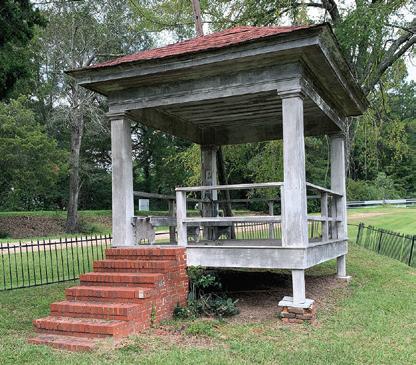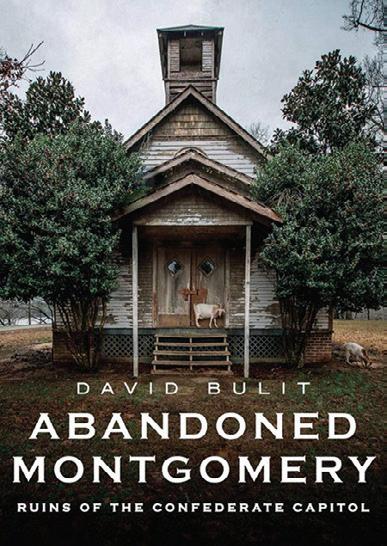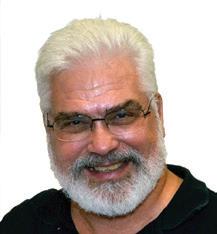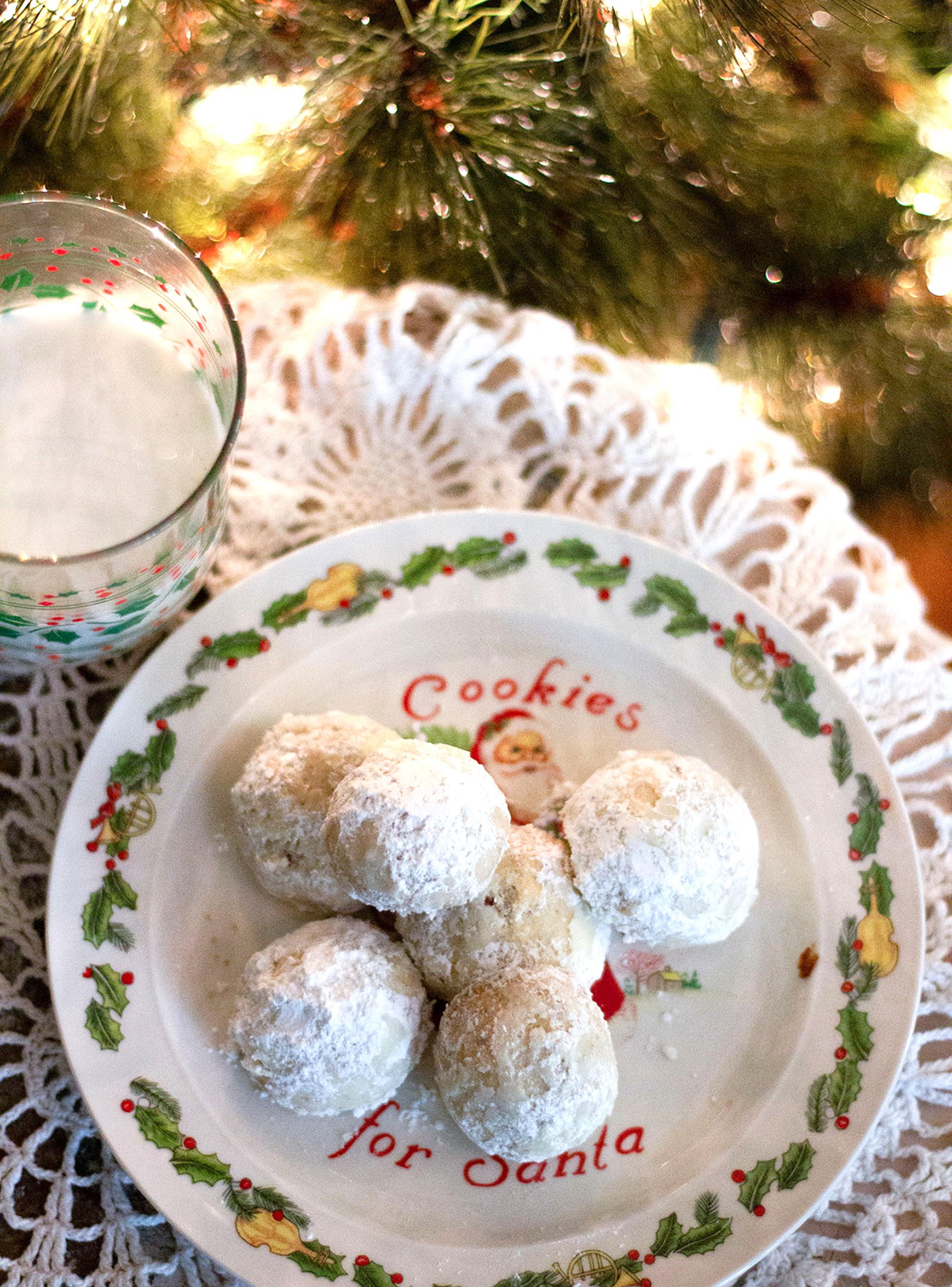






ALABAMA LIVING is delivered to some 420,000 Alabama families and businesses, which are members of 22 not-for-profit, consumer-owned, locally directed and taxpaying electric cooperatives. Subscriptions are $12 a year for individuals not subscribing through participating Alabama electric cooperatives. Alabama Living (USPS 029-920) is published monthly by the Alabama Rural Electric Association of Cooperatives. Periodicals postage paid at Montgomery, Alabama, and at additional mailing office.
POSTMASTER send forms 3579 to:
Alabama Living, P.O. Box 244014 Montgomery, Alabama 36124-4014.
AREA President
Karl Rayborn
Editor
Lenore Vickrey
Managing Editor
Allison Law
Creative Director
Mark Stephenson Art Director
Danny Weston Advertising Director
Jacob Johnson
Graphic Designer/Production Coordinator
Brooke Echols
ADVERTISING & EDITORIAL OFFICES: 340 TechnaCenter Drive Montgomery, Alabama 36117-6031 1-800-410-2737


For advertising, email: advertising@areapower.com For editorial inquiries, email: contact@alabamaliving.coop

NATIONAL ADVERTISING REPRESENTATIVE: American MainStreet Publications 611 South Congress Ave., Suite 504 Austin, Texas 78704 1-800-626-1181 www.AMP.coop www.alabamaliving.coop

ISSN 1047-0311

Favorite decorations From ornaments to Nativity scenes, our readers share their favorite decorations for the season.


Anniston’s Berman Museum, known for its historic weaponry collections, offers even more for visitors.
Mistletoe, a holiday favorite, has both a good side and a potentially bad side.
Karlton Jenkins of Wetumpka, who goes by the name Kringle Klaus this time of year, got an early start on his Christmas cookie treats with some of our contest entries. See the winners, Page 34.
PHOTO: Brooke Echols

Alabama Gov. Kay Ivey joined local leaders and dignitaries on the banks of the Tombigbee River last month to open Demopo lis City Landing, enabling the area to capitalize on the increase in fishing participation and providing the ability to host local, regional and major fishing tournaments on the Tombigbee and Black Warrior rivers.

“I am honored to be here to cut the ribbon on the new boat ramp here in Demopolis,” Gov. Ivey said. “Truly, this first-class project demonstrates the efficiency of Alabama cooperation. Working together with the Alabama Department of Conserva tion and Natural Resources (ADCNR), the City of Demopolis and Marengo County brought this $3 million investment to west Ala bama, which will provide millions of dollars of economic benefit to our Black Belt region of the state.”
The Demopolis City Landing provides a four-lane boat launch with 53 paved parking spots, three handicapped parking sports, green-space parking for hundreds more and 250 feet of docking space.
“Here in Alabama, we are presented with the unique opportu nity to not only use our state’s bountiful natural resources to grow our economy but to improve the quality of life of Alabamians through the encouragement of the use of our outdoor recreation,”
she said. “This project will allow the Demopolis community to capitalize on great fishing on the Black Warrior and Tombigbee rivers. In fact, with this facility, Marengo County can now host regional and national bass tournaments to help promote access to these waters. Our friends at Alabama Power Company and B.A.S.S. (Bass Anglers Sportsman Society) have continued their longstanding partnership by providing a pavilion for a muchneeded space for organizations, from local bass clubs to the largest tournaments, to hold their weigh-ins. And folks, I have participated in a bass weigh-in, so I know that having some space will be yet another plus.
“I fully expect to watch the tourism industry grow even more after the opening of this boat ramp here in Demopolis. We’re known as ‘Alabama the Beautiful’ for a reason, and this opening will allow more of our families, from far and near, to get out and experience our great state. Folks, this project is not an end but just the beginning. In the next few weeks, Commissioner (Chris) Blankenship and the Conservation Department will be develop ing more boating access like here in Demopolis, but I know this one here in Marengo County will be tough to beat. May God con tinue to bless each of you and the great state of Alabama.”
Marengo County Commissioner Jason Windham said the proj
ect went through many starts and stops before it reached fruition.
Bids for the project came in double the original estimate. To continue the project and complete the landing, ADCNR increased the funding they were providing, and the Marengo County Com mission, the Marengo County Economic Development Author ity, the Marengo Parks and Recreation Board, the Demopolis Parks and Recreation Board and the City of Demopolis formed a coalition to help fund the additional local match for the proj ect. Alabama Power and B.A.S.S. provided funding toward the construction of two pavilions. Local businesses and companies provided other assets to complete the pavilions.
“It’s been an amazing adventure and amazing journey,” Windham said. “What we figured out was that when the City of Demopolis and Marengo County need to come together, they do. I’m proud to stand here today and say we landed the plane.”
Demopolis Mayor Woody Collins added, “If we tried to thank everybody, we’d be here for hours. There were so many people behind the scenes that have contributed. We know who you are, and we appreciate you so much.”
Commissioner Blankenship said he and Deputy Commis sioner Ed Poolos traveled to Demopolis and met with Padilla and Demopolis and Marengo County officials and quickly recognized the need for the launch facility and what it could mean for this area.

Commissioner Blankenship and Deputy Commissioner Poolos returned to Montgomery and met with ADCNR staff to devise a plan to find funding for the project and move it up in the priority list of other projects scheduled around the state. They also worked with the (U.S. Army) Corps of Engineers to speed up the permit ting process to allow the work to proceed.
“The passion these guys have for their community and their plan to do something big like this was contagious,” Commissioner
Blankenship said. “None of us had the money to do this project alone, but we figured that if we all pulled together, we could get it done. As with any project like this, there were challenges, but any time I called Jason or the mayor, these guys were great, and we worked through every problem. When the bids came in double, I was so thankful we were able to work together to make this happen. The river above flood stage, the bids over budget, soupy soil, rock that had to be drilled to put the pilings down, relocat ing endangered mussels and other issues were handled quickly and professionally, which goes to show that, if you’re interested in working together and want to make things happen, you can.”
Commissioner Blankenship said the improvements in access to Alabama’s great outdoors have numerous benefits that may not be readily recognized.
“Alabama is truly blessed with woods and waters from one end of the state to the other,” Commissioner Blankenship said. “The Black Belt is such a beautiful and important part of our state. I’m glad to be here to dedicate this new facility. With the spectacular fishing in all the various waterways, demand for boating access is through the roof here in Demopolis. Building public access is a priority for me as the Commissioner. Acquisition of public hunting land and other public recreational land, building tour nament-style boat ramps and piers, trail-building and blueway creation are all in progress around the state.
“Expanding outdoor recreation is one of the biggest opportuni ties that we have to retain workers in Alabama,” he said. “Having a facility like this in west Alabama will really help this part of the state capitalize on the natural resources that God so richly blessed this area with.”
A variety of factors like extreme weather and increased use of renewable energy are affecting the electric utility industry so much that there’s even a new way to talk about it: resilience.
You might be surprised to learn that “resilience” isn’t exactly used to describe the major changes affecting electricity service. Instead, it’s about actionable steps electric utilities are taking to keep power flowing.
Just a few years ago, “reliability” was the term of choice. Reli ability meant trimming trees near power lines and keeping squir rels from chewing up electrical equipment. Attention to those priorities worked. The average American’s electricity stayed on well over 99.9% of the time. That reliability record is still holding up, but it’s under pressure on several emerging fronts.
More powerful and frequent natural disasters and even the growing fleets of electric vehicles call for all electric utilities to learn new ways to do their job. These days, maintaining the power grid means planning for sudden and large-scale disruptions.
If you’re not sure what the difference is between “reliability” and “resilience,” you’re not alone. Even utilities can have slightly different definitions. But most tend to agree that grid resiliency is the ability to withstand and recover from disruptive events and to predict and adapt to ensure consumers have the reliable power they need in a time of new energy challenges.
A less-formal definition from the Future Electric Utility Reg ulation Advisory Group compares electric service to a boxing match:
“Reliability is when you can take a punch. Resilience is how fast you get up off the canvas after you’ve been hit hard.”
Electricity is more important than ever to our daily lives. At the same time, weather events can suddenly take that essential electricity away from large numbers of people. Utilities need to be ready to get back up off the canvas quickly. And that’s what they’re doing, from burying more power lines underground to outage recovery plans that get the most essential services back online first. Last year, Congress passed and the White House signed a law that includes a $10.5 billion Grid Resilience and Innovation Partnership Program.
Here are a few other ways electric utilities are building resil ience:

Cybersecurity is an example of government and utilities work ing closely together, sharing information to protect against the latest cyber threats. In other cases, one size does not fit all.
Electric cooperatives in particular point out that resilience means paying attention to regional and local differences. Raising
substations higher off the ground might make sense in floodprone areas while wrapping utility poles with fire-resistant cover ings could be considered where wildfires are a threat.
One idea being tried is to create small areas that can supply their own electricity in the case of a widespread outage, using a combination of energy sources like wind and solar power, largescale storage batteries and diesel generators.

Electric utilities are investing to build power lines that connect to new sources of renewable energy. They’re also investing in digital equipment and sensors that can more quickly detect and resolve power outages or other problems.
Rooftop solar arrays that allow homeowners to sell excess power back to the utility offer an example of another major change in the electric industry. It’s called Distributed Energy Resources, or DER, which describes home generators, batteries and other energy sources. The challenge for utilities is to integrate those power sources, that could be variable and intermittent, into the smooth flow of electricity on the grid.
There are opportunities as well—the growing numbers of electric vehicles plugged in overnight could be seen as a huge energy drain on the grid when the batteries in the electric cars are charging. Or those same batteries, when fully charged, could be a source of reserve power to supply the home in case of a large, unplanned outage.
There’s no doubt that major changes to the way we generate and consume energy are happening. But utilities, including electric cooperatives, are answering the call with innovative solutions to serve their local communities. That’s called resilience.
Paul Wesslund writes on consumer and cooperative affairs for the National Rural Electric Cooperative Association, the national trade association representing more than 900 local electric cooperatives. From growing suburbs to remote farming communities, electric co-ops serve as engines of economic development for 42 million Americans across 56% of the nation’s landscape.
 By Abby Berry
By Abby Berry
We all have our favorite season. Some people love crisp, cool weather and bundling up under a favorite blanket, while others prefer the warm temperatures summer brings and all fun outdoor activities that go with it. But there’s one thing we can all agree on: high winter bills are never fun.
• Mind the thermostat. This is one of the easiest ways to manage your home energy use. We recommend setting your thermostat to 68 degrees (or lower) when you’re home. When you’re sleeping or away for an extended period of time, try setting it between 58 and 62 degrees; there’s no need to heat your home when you’re away or sleeping and less active.
• Button up your home. The Department of Energy estimates that air leaks account for 24% to 40% of the energy used for heating and cooling a home. Caulking and weather stripping around windows and doors is another simple, cost-effective way to increase comfort and save energy. If you can feel drafts while standing near a window or door, it likely needs to be sealed.
• Use window coverings wisely. Open blinds, drapes or other window coverings during the day to allow natural sunlight in to warm your home. Close them at night to keep the cold, drafty air out. If you feel cold air around windows, consider hanging curtains or drapes in a thicker material; heavier win dow coverings can make a significant difference in blocking cold outdoor air.
• Consider your approach to appliance use. When combined, appliances and electronics account for a significant chunk of our home energy use, so assess how efficiently you’re using them. For example, if you’re running the dishwasher or clothes washer, only wash full loads. Look for electronic devices that consume energy even when they’re not in use, like phone chargers or game consoles. Every little bit helps, so unplug them to save energy.
• Think outside the box. If you’re still feeling chilly at home, think of other ways to warm up––beyond dialing up the ther mostat. Add layers of clothing, wear thick socks and bundle up under blankets. You can even add layers to your home! If you have hard-surface flooring, consider purchasing an area rug to block cold air that leaks in through the floor.
Winter months often bring some of the highest energy bills of the year. By being proactive about saving energy, you can increase the comfort of your home and reduce monthly bills.
Abby Berry writes on consumer and cooperative affairs for the National Rural Electric Cooperative Association, the national trade association representing more than 900 local electric cooperatives. From growing suburbs to remote farming communities, electric co-ops serve as engines of economic development for 42 million Americans across 56% of the nation’s landscape.
During winter months, set your thermostat to 68 degrees when you are home.

When running larger appliances like the washing machine or dishwasher, only wash full loads to maximize efficiency.
 Get cozy under your favorite blanket for additional warmth. Don’t forget to bundle up your furry friends, too.
Get cozy under your favorite blanket for additional warmth. Don’t forget to bundle up your furry friends, too.





SUBMITTED by Susanlynn Allen, Guntersville.

The town of Andalusia turns into a Christmas wonderland in December, so bring the fam ily down to south Alabama and make some magical holiday memories.
The downtown square will feature a “snow show,” with ma chines blasting authentic-look ing snowflakes each day the event is open. Catch a horsedrawn carriage ride around the square and take some photos in front of the massive Christmas tree.
Just up the road at the Spring dale estate are visits with Santa and Elsa in her enchanted fro zen garden. Take a ride around the estate on a replica of a classic steam locomotive. Follow the journey of a lost polar bear club through a large inflatable maze. The Polar Bear Tubing Hill has two 150-foot lanes for snow racing tubes. And wear your tall socks to take a spin on the ice in the winter skating experience.
Perhaps the most visible parts of Candyland are the villages (one at Springdale, and one on the square) of child-sized imagi native playhouses, custom designed, built and sponsored by local businesses.
Many of these attractions are free; some of the activities have a nominal cost. Visit ChristmasinCandyland.com for specific times and more information.


When the temperature drops, it can become more difficult to maintain your motivation to keep moving and stay active. Healthmed offers some tips to help:
• Look into Vitamin D. The sunshine vitamin helps to keep you strong both mentally and physically. Of course, the eas iest source is from the sun, so get outside when you can!
• Regular exercise helps to strengthen your immune system.
• Winter blues are no joke; exercise helps our body release se rotonin and dopamine, which can help reduce anxiety and depression.
• Avoid winter weight gain. With lots of holiday comfort foods around, it’s easy to lose focus on eating healthfully.
I read your articles in the Alabama Living magazine. You’re my favorite part of the magazine. I come from a small town and you write about a South that I remember as a kid. Being in a small town, we lived in the “old ways” longer, I think. You always have a good story that usually invokes memories and laughter, but this month’s article, “Remembering” (Hardy Jackson’s Alabama, No vember 2022), was different. It reminded me on the 70s, Viet nam, POWs, MIAs, and the death of too many. This time your story didn’t bring laughter but tears. It may just be your best story yet. Good job!
Donna K. Frazier, Woodville
Wonderful article. Now if we can convince people that Veter ans Day is not car and mattress sale extravaganza! Also, that Me morial Day ISN’T the first big cookout of the summer, along with aforementioned sales.
Chuck Hall, MM1(SW), USN Retired Dawson
Thanks to all those who found the “timely” dingbat last month! We made it easier than usual, putting the alarm clock on the man’s wristwatch on Page 22. Debra Shotts of Clio, a member of Pea River EC, wrote us that she almost got sidetracked while looking for the clock, and thought she spotted it on the napkin dispens ers on Page 13 of the Auburn culinary center article. “But then I thought to myself, you wouldn’t put it in that many times, that’s TOO easy!” You’re right, Debra! Arwen Higginbotham wrote that he and his grandfather have made it a monthly tradition to hunt for the dingbat together. “I find them every month, but this is the first time that I have gotten brave enough to submit it,” he wrote.

Diane Keef of Rainsville told us that she and her husband enjoy playing along but had not found a dingbat until November’s issue. “It was like a championship touchdown!” she said. We especially like to hear that our younger readers enjoy finding the hidden dingbat. Lisa Coumanis of Daphne said her 10-year-old daughter found the clock and they like looking for it together each month. A reader named “David” (next time, give us your whole name, David!), age 11, told us he found it “in about one minute.”

Congratulations to Central Alabama Electric Cooperative member Louie Albert Woolbright of Prattville, our randomly drawn winner who wins a gift package from Alabama One Cred it Union. This month we’ve hidden a Christmas stocking, so we wish all our dingbat hunters out there good luck and a Merry Christmas! Remember: it won’t be in an advertisement and it won’t be on Pages 1-8.

By mail: Find the Dingbat Alabama Living PO Box 244014 Montgomery, AL 36124
By email: dingbat@alabamaliving.com
Sponsored by
Identify and place this Alabama landmark and you could win $25! Winner is chosen at random from all correct entries. Multi ple entries from the same person will be disqualified. Send your answer with your name, address and the name of your rural elec tric cooperative, if applicable. The winner and answer will be an nounced in the January issue.
Submit by email: whereville@alabamaliving.coop, or by mail: Whereville, P.O. Box 244014, Montgomery, AL 36124.

Contribute a photo you took for an upcoming issue! Send a photo of an interesting or unusual landmark in Alabama, which must be accessible to the public. A reader whose photo is chosen will also win $25.

November’s answer: This 19thcentury bandstand occupies the triangular park in the town of Gainesville in Sumter County. The town was founded by Moses Lewis, a New Englander lured to the “old Southwest,” as the Gulf states were known in the early 19th century. Gainesville, on the Tombigbee River, was a prosperous town in the antebellum period, but has a population of about 200 today. (Information from the Society of Architectural Historians; photo by Allison Law of Alabama Living.) The randomly drawn correct guess winner is Thomas Butler of Coosa Valley EC.






We’ve enjoyed seeing photos from our readers on their travels with Alabama Liv ing! Please send us a photo of you with a copy of the magazine on your travels to: mytravels@alabamaliving.coop. Be sure to include your name, hometown and electric cooperative, and the location of your photo.We’ll draw a winner for the $25 prize each month.
Four families from Moulton visited one of the slot canyons in Page, Arizona, in June:
Warren and Trina Clark, Donny and Frances Blankenship, Jeff and Tina Blankenship, and Carolyn Hall. All are members of Joe Wheeler EMC.

due to cervical kyphosis. He was not al lowed to be ordained as a priest due to the rule that stated any man with a dis tracting disability could not be ordained a priest. He was considered a withdrawn, quiet man. After he arrived at the newly founded abbey, he spent his days praying and laboring in the powerhouse. When not busy shoveling coal into the furnaces, he constructed the miniatures.
He began making the first replicas in about 1912 and his last, the miniature of the beautiful Lourdes Basilica Church, in 1958 when he was 80 years old. He used rock and concrete to construct each build ing and marbles, glassware, seashells, tiny ceramic tiles and other objects to decorate the facades.

The tiny buildings were initially in the abbey gardens, but when so many visitors wanted to see them, they were eventually moved to their present home in 1934.
Visitors from around the world have journeyed here to see the tiny treasures.
The four-acre park is filled with lovely flowers, English ivy and towering trees. Nature has crept in on the tiny buildings making them seem like they were always part of the landscape.
As I walk past The Temple of the Fair ies, Leaning Tower of Pisa, The Alamo, Montserrat, St. Peter’s Basilica, and 120 other small structures, I am amazed at his artistry detail and the apparent love that went into their creation.
Half of the hillside features buildings and scenes from the Holy Land. Also displayed are a number of secular build ings including Spanish missions, Ger man castles, South African shrines and the St. Bernard Abbey power station.
His creations came from his exten sive reading. He rarely left Alabama during his lifetime. Of all the structures, he had only seen four. The others were designed by using photographs and de tailed written descriptions.
Brother Joseph died in 1961 at the age of 83 and is buried in the Abbey Cem etery. He was a monk of the abbey for 70 years.
Buildings hug the grotto walls allowing guests to easily view the tiny buildings and villages.
It takes me the better part of an hour to walk the two-block distance. There is such detail in each piece and village. Tiny stair cases, statues and decorations add to the charm of each work of art.
About halfway through the tour is a statue of Brother Joseph. On its base is the inscription “Brother Joseph Zoettl, O.S.B., Creator of Ave Maria Grotto, Ora Et Lab ora,1878 – 1961.”
At the end of the tour are several other structures created after Brother Joseph’s death. Leo Schwaiger cared for the grot to from 1963 until his retirement in 2014 and, most notably, made the four Marian Shrines.
It was added to the Alabama Register of Landmarks and Heritage in 1976 and the National Register of Historic Places in 1984.
Ave Maria Grotto is open Monday through Saturday from 9 a.m. to 5 p.m. and Sunday 11:30 to 5 p.m. except New Year’s Day, Easter, July 4th, Thanksgiving and Christmas. It is located in Cullman at 1600 St. Bernard Dr. SE. For more in formation: check avemariagrotto.com or call (256) 734-4110.


For the Christmas season, the Ave Maria Grotto will be decorated with Christmas lights and music will be fea tured, along with horse carriage rides. On December 17 and 18 there will be live music from the St. Bernard monks sing ing Gregorian chants, and traditional Christmas tunes will be performed in Appalachian style. Johnny’s BBQ food truck will be on-site both nights, the Grotto’s picnic grounds will be lit up for use and horse-drawn wagon rides around the campus with a storyteller will be featured.

Dates: Dec. 2, 3, 4 – 5-9 p.m. Dec. 9, 10, 11 – 5-9 p.m. Dec. 16, 17, 18 – 5-9 p.m. Dec. 22, 23 – 5-9 p.m. Dec. 30, 31 – 5-9 p.m.
In neighboring Hanceville, there is another religious destination open to individuals and families. Shrine of the Most Blessed Sacrament is a prominent Roman Catholic Latin Rite shrine locat ed in a beautiful rural setting.
The Shrine is notable for its gilt inte rior, solemn atmosphere, and 7.5-foot monstrance. The site is quiet and peace ful. Roses frame many of the buildings.
The shrine is located at 3224 County Road 548. For more information: check olamshrine.com or call (256) 352-6267.
Lots of people think of the Berman Museum in Anniston as the “gun museum.” That’s no surprise, since the core of the museum’s extensive collection includes thousands of weap ons that span the history of firearms. It’s the place where you can find rifles and pistols and machine guns that belonged to such historic figures as Catherine the Great, Jefferson Davis, Belle Starr, Kaiser Wilhelm and Napoleon III – to name just a few.
But there is a lot more to the Berman Museum than guns.
When it opened its doors in 1996, the museum got a lot of bang for its buck by banking on the famous weapons it exhibited. It drew visitors from around the country who were surprised to find such storied artifacts in a small Alabama city. It also became a popular school trip destination for students who were studying the wars that shaped Europe, Asia, Africa and their own country as well.
Then the Covid pandemic hit. The crowds stopped coming (temporarily), and the museum’s operators had time to re-think the stories they wanted to tell through their displays. Instead of general historical trends illustrated by the items in the collection, they crafted narratives that would integrate the famous artifacts
on display. And for the first time they added new hands-on com ponents in each gallery so that young visitors (and everyone else who likes to play with things) get an enhanced experience through tactile learning.
The pandemic closed the museum to visitors for 67 days, so the staff used that quiet time to finalize their long-range plans, do deep cleaning, and write grant proposals for future projects. When it re-opened for guests, the museum had a new floor plan and a new focus.
“Pretty much everything is different,” says Alan Robison, exec utive director of the Anniston Museums and Gardens, the parent organization of the Berman Museum. “It’s a new way of looking at the museum – new galleries, new exhibits.”


some extra time on their hands should ask about taking The Discovery Tour – a visit to the museum’s basement. With roughly four-fifths of the collection not being part of the regular display at any given time, this is a great way to get a real sense of how extensive the museum’s holdings re ally are. Plus, your tour guide can answer questions and let you in on some of the museum’s secrets.
The rules are simple: a Discovery Tour must be booked in advance, it can include no more than 10 people, and even though you are much closer to the artifacts you still can’t touch them. There’s an extra fee involved, too.

This Gatling gun model was made after the Civil War and has 10 barrels that were fed by the attached drum magazine in the back. It could fire more than 1,000 rounds per minute.


The Berman Museum, 800 Museum Drive, Anniston, is open 10 a.m. to 5 p.m. Tuesday-Saturday, with the last admission sold at 4:30 p.m.; 1 p.m. to 5 p.m. Sundays, with the last admission sold at 4:30 p.m. The museum is closed Easter Day, Thanksgiving Day, Christmas and New Year’s.
Tickets are $8 for adults, $7 for seniors, $6 for children with children under 3 free.
A Passport Ticket, which includes admission to the Anniston Museum of Natural History along with the Berman Museum, is $12 for adults, $10 for seniors, $8 for children and children under 3 free.
For more details, and to make reservations, visit exploreamag.org or call (256) 237-6261.




Nicole Penn, Eclectic
6 to 8 pieces of chicken
1/4 cup brown sugar
1 tablespoon garlic powder
1 teaspoon paprika
1 Scotch Bonnet pepper, seeded and chopped
½ teaspoon sea salt
1/4 cup white vinegar
2 cups chopped red, green & yellow bell peppers
1 onion, sliced
1 tablespoon olive oil
2 cups prepared mashed potatoes, or starch of your choice
Rinse and pat dry chicken pieces. Place in a Ziploc bag. Add the next six ingredi ents and seal bag. Shake to coat chicken. Marinate for one to 24 hours if desired. Pour chicken into crockpot and add chopped peppers and sliced onion. Drizzle with olive oil. Toss to coat. Cook on high for 4 hours or until chicken is tender. Serve with mashed potatoes.


Mary Lyons, Tallassee
½ large cabbage, sliced
1 medium onion, diced
1 stick butter
2 cups fresh cut corn
6 large potatoes, cut and diced
1 teaspoon salt
2 teaspoons black pepper
2 green bell peppers, sliced
2 cans crescent rolls
1 egg white for wash

1 large can cream of mushroom soup
1 package brown gravy mix
1 package of stew beef
1 cup water
2 tablespoons balsamic vinegar
1 teaspoon minced garlic
2 tablespoons parsley
1 teaspoon black pepper
Cut and dice potatoes and cook on stove top until tender. Cook fresh cut corn on stove top on medium for 30 minutes. Set aside. In a large pot, sauté onion and bell pepper until onion is transparent, then add stew beef. Cook on medium heat for 15 minutes, then add water, brown gravy mix and cream of mushroom soup. Continue to cook on medium, stirring often.
Cook cabbage in pot on stove top with butter. Add balsamic vinegar, garlic, parsley and pepper. Stir well. Continue to stir until cabbage is soft and transparent. Spray the bottom of your baking dish with Pam cooking spray. Roll out one can of crescent rolls and place on bottom of the dish. Add potatoes and corn, then cabbage, then meat mixture with mushroom soup on top of cabbage. Add second can of crescent rolls on top in single layer. Brush on egg white wash. Bake at 360 degrees for 30 minutes or until top is golden brown. Sprinkle black pepper on top.


In this periodic feature, we highlight books either about Alabama people or events, or written by Alabama authors. Summaries are not reviews or endorsements. We also occasionally highlight book-related events. Email submissions to bookshelf@alabamaliving.coop. Due to the volume of submissions, we are unable to feature all the books we receive.

Distracted by Alabama: Tangled Threads of Natural History, Local History, and Folklore, by James Seay Brown, Univer sity of Alabama Press, $39.95. When the author moved to Birmingham to teach at Samford University, he began to explore Alabama’s rivers and countryside. He was enchanted by both the myriad animals and plants he discovered and the surviving old-time settler and Native American folk ways. The book records his investigations into the rich diversity of Alabama’s history, cultural traditions and environment.


With the Devil’s Help: A True Story of Poverty, Mental Illness, and Murder, by Neal Wooten, Pegasus Crime, $23.31 (crime/criminal biographies) Wooten’s family lived in poverty in a tiny commu nity atop Sand Mountain in northeast Alabama. Growing up, Wooten learned the folklore legends of his grandfather; told from two perspectives, this book alternates between Wooten’s life and his grandfather’s, culminating in a shocking revelation.


100 Things to Do on the Alabama Gulf Coast Before You Die, by John Mullen, Reedy Press, $15.75 (travel) The book will help visitors make the most of their visit with itineraries, insider tips and a local’s perspective. Explore the bustling resort towns as well as the natural environments of the Bon Secour National Wildlife Ref uge and Weeks Bay National Estuarine Re search Reserve. Whether you’re fishing for world-class red snapper or just enjoying a vacation, you’ll find spots to explore.


Abandoned Montgomery: Ruins of the Confederate Capitol, by David Bulit, America Through Time, $23.99 (histo ry) Montgomery, the birthplace of the Confederacy and the site of many crucial civil rights events, has a storied history. Its buildings are a reminder of its sometimes controversial past; the author, a photogra pher and historian, guides readers through some of the structures that have been neglected and face possible ruin.
Drifting Into Darkness: Murder, Madness, Suicide, and a Death ‘Under Suspicious Circumstances,’ by Mark I. Pinsky, New South Books, $23.95 (true crime) This book centers on the true story of Mont gomery philanthropists Charlotte and Brent Springford Sr., who were brutally beaten to death in 2004. Suspicions fell on the couple’s son, Brent Jr., who would be tried and sentenced to life in prison. Pinsky is a veteran crime reporter who broke the cardinal rule of journalism by involving himself in the story, which gave him a unique access into the case.
History of the 60 Commercial Buildings Developed by the Retirement Systems of Alabama, by Mark Fagan, $50 (architec ture) Since 1977, the RSA has developed 15 million square feet of commercial buildings as alternative investments. Some were constructed by RSA, while others were purchased and refurbished. Such developments help revitalize downtown areas and in some cases preserve historical structures. This book explains how each building was acquired or built, developed and/or improved. Photos from several sources show the developmental progress of the buildings.



A:Winterizing is an important step to keep your home cozy and your bills low. These tried-and-true methods will ensure your home is sealed tight and ready for colder weather. I’ve also included tips that address common misconceptions.
You can raise the water temperature inside your home’s water pipes by 2 to 4 degrees by insulating, according to the U.S. De partment of Energy (DOE). Insulating allows you to turn down the heat on your water heater, saving energy and money.
Start by insulating the pipes coming out of your water heater. If you have a gas water heater, keep pipe insulation at least 6 inches away from the flue. Insulate hot and cold water lines. The latter can prevent condensation and freezing pipes. Insulating your wa ter heater can save 7% to 16% on water-heating costs, DOE says. Insulation kits are available at hardware stores. Don’t obstruct the pressure relief valve, thermostats or access valves.
Air sealing and insulation are a great combination for mini mizing home energy use. Insulation is like a warm sweater for your home, and air sealing is the wind breaker. All the cracks, gaps and holes in a typical home can be like having a window open year-round. Air sealing eliminates those leaks. It can be done as a do-it-yourself project or by a professional.
Windows can be a source of drafts and wasted energy. Close windows tightly.
Add weatherstripping around windows to prevent warm air from escaping your home and caulk the gaps where the window trim meets the wall and the window frame. Add curtains to make the room feel warmer.
Storm windows are a lower-cost option for upgrading sin gle-pane windows. They are available with low-emissivity coat ings, which insulate better, and are available for installation either from the inside or outside of the window.
When I was little, my dad told me it was too cold to have a fire. I remember thinking that made no sense, but he was right.
We had an open, wood-burning fireplace—not a wood stove. A fireplace can draw the warm air out of the house, cooling it down or causing your heating system to use more energy.
Your fireplace adds ambience to your home but isn’t necessarily effective at heating it. If you have a wood-burning fireplace, close
the damper when your fire is extinguished. An open damper in the winter is an easy exit for the air you paid to heat.
Adding tempered glass doors to a wood-burning fireplace can create an extra buffer between the cold outside and a cozy living space.
Some gas fireplaces require a damper to remain permanently open so gas can vent out of the home. Check the specifications of your unit to ensure safe operation.

Through the years, I have heard a lot of debate about closing off rooms or parts of the home to save energy.
Best practices come down to the type of heat source. If you have a zonal heating system, where individual areas are con trolled separately, you can close doors and only heat the areas you use. Examples of zonal systems are wall heaters, baseboard heat, hydronic radiant heat, radiators and ductless heat pumps, also called mini-splits.
Keep areas with plumbing or water lines warm enough so pipes do not freeze.
If you have a central forced-air heating system, leave doors open to all heated areas. Closing doors and/or register damp ers forces the system to work harder, uses more energy and can shorten the life of heating equipment.
Maintaining a clean filter in your furnace is one of the best ways to keep it running efficiently and prevent costly repairs. Check your furnace or ductless heat pump filter monthly during peak heating season.
Q: How can I keep my home warm while saving on my electric bill this winter?Miranda Boutelle is the vice president of operations and customer engagement at Efficiency Services Group in Oregon, a cooperatively owned energy efficiency company. She also writes on energy efficiency topics for the National Rural Electric Cooperative Association, the national trade association representing more than 900 local electric cooperatives. Insulating your water heater can save 7% to 16% on water heating costs, according to the U.S. Department of Energy. PHOTO COURTESY MARK GILLILAND, PIONEER UTILITY RESOURCES



Approximately 70 million Americans will see an 8.7% increase in their Social Security benefits and Supplemental Security Income (SSI) payments in 2023. On average, Social Security benefits will increase by more than $140 per month starting in January.
Federal benefit rates increase when the cost-of-living rises, as measured by the Department of Labor’s Consumer Price Index (CPI-W). The CPI-W rises when inflation increases, leading to a higher cost-of-living. This change means prices for goods and services, on average, are higher. The cost-of-living adjustment (COLA) helps to offset these costs.
We will mail COLA notices throughout the month of Decem ber to retirement, survivors, and disability beneficiaries, SSI re cipients, and representative payees. But if you want to know your new benefit amount sooner, you can securely obtain your Social Security COLA notice online using the Message Center in your personal my Social Security account. You can access this infor mation in early December, prior to receiving the mailed notice. Benefit amounts will not be available before December. Since you will receive the COLA notice online or in the mail, you don’t need to contact us to get your new benefit amount.
If you prefer to access your COLA notice online and not re

ceive the mailed notice, you can log in to your personal my Social Security account to opt out by changing your Preferences in the Message Center. You can update your preferences to opt out of the mailed COLA notice, and any other notices that are avail able online. Did you know you can receive a text or email alert when there is a new message waiting for you? That way, you al ways know when we have something important for you – like your COLA notice. If you don’t have an account yet, you must create one by November 15, 2022, to receive the 2023 COLA no tice online.
“Medicare premiums are going down and Social Security ben efits are going up in 2023, which will give seniors more peace of mind and breathing room. This year’s substantial Social Security cost-of-living adjustment is the first time in over a decade that Medicare premiums are not rising and shows that we can provide more support to older Americans who count on the benefits they have earned,” says Acting Commissioner Kilolo Kijakazi.
January 2023 marks when other changes will happen based on the increase in the national average wage index. For example, the maximum amount of earnings subject to Social Security payroll tax in 2023 will be higher. The retirement earnings test exempt amount will also change in 2023.
Be among the first to know! Sign up for or log in to your person al my Social Security account today. Choose email or text under “Message Center Preferences” to receive courtesy notifications.

You can find more information about the 2023 COLA at ssa. gov/cola
by Myles Mellor
Christmas in Ansley 5735 County Road 1135, Troy, Ala., 36081. This drive-through Christmas lights display will feature a holiday market, arts and crafts, costumed characters, Santa visits with hot chocolate and goodies available. Search the event’s Facebook page for detailed schedules.

Montgomery 17th annual Interfaith Nativity Exhibit. 1 to 8 p.m. daily, 3460 Carter Hill Road. Live music each evening, with a seniors and veterans concert at 11:30 a.m. Dec. 1. Food donations for the Montgomery Area Food Bank will be accepted. MontgomeryNativity.com
Montgomery 52nd annual Gem, Mineral and Jewelry Show, Garrett Coliseum. 9 a.m. to 6 p.m. Friday and Saturday and 11 a.m. to 4 p.m. Sunday. Mgms.club
Eufaula 16th annual Christmas Tour of Homes. Homes open 1 to 5 p.m. daily. See lovely, unique homes decorated for Christmas. Tickets range from $5 for one home to $40 for all eight homes on tour.
EufaulaPilgrimage.com
Enterprise “Messiah,” a community choral presentation, 5 p.m. at First Baptist Church. A presentation of Handel’s most beloved work. Free but donations are welcome.



CoffeeCountyArtsAlliance.com
Wetumpka Christmas on the Coosa, in downtown and Gold Star Park. Day begins with two sessions of the annual character breakfast, at 7:30 a.m. and 9:30 a.m. Arts and crafts vendors will be set up all day beginning at 12 p.m., and the antique car show will be from 12 to 3 p.m. Night parade begins at 6 p.m. Santa will ski across the Coosa River at 7 p.m., with fireworks after. Wetumpkaal.gov
Orange Beach Flora-Bama annual Santa drop, 11 a.m. to 2 p.m. See Santa skydive onto the white sandy beaches at noon; there will also be kids’ crafts, games, live music featuring holiday tunes, face painting and more. Free. Florabama.com
Decatur Historic Decatur Christmas Tour, 12 p.m. Songs by costumed carolers, visits with Santa Claus, carriage rides (weather permitting), holiday market and bell choir in addition to historic homes tours, which begin at 3 p.m. DecaturChristmasTour.com

Opelika Victorian Front Porch Christmas tour. Homes in Opelika’s northside historic district are transformed into a colorful, nostalgic reminder of Christmas. Each night is a self-directed driving tour except for Saturday, when streets will be closed to encourage foot traffic. Carolers, residents dressed in Victorian costumes and more. Tour begins at Heritage House on North 8th Street. Free. Opelika-al.gov
Dothan Victorian Christmas at Landmark Park. 1 to 4 p.m. Listen to Christmas carols and visit with Santa. Snacks, arts and crafts, music, wagon rides and handmade decorations. A circuit-riding preacher will deliver a holiday message. Free. LandmarkParkDothan.com
Prattville A Main Street Christmas, 5 to 7:30 p.m. in the downtown historic district. Shop local small businesses, visit with Santa, enjoy a free carriage ride and more. Search for the event’s page on Facebook.
Warrior
Wonderland Under Warrior. The cave at Rickwood Caverns State Park is transformed into an underground winter wonderland. The gift shop will be decorated and offer unique gifts, ornaments, snacks and hot cocoa. Event is from 2 p.m. to 8 p.m. on various dates; visit alapark.com/parks/rickwoodcaverns-state-park for the calendar of available dates and Santa hours.
Mobile MoonPie Over Mobile. Ring in 2023 with one of the most unusual celebrations. Beginning at 8 p.m., dig into the world’s largest MoonPie cake, see live entertainment and enjoy a fireworks show. A 600-pound electric MoonPie drops at midnight. Mobile.org
If you’re searching for a sprig of mis tletoe to smooch under this holiday season, look up. It’s quite likely large clumps of this fascinating plant are right overhead where they’ve been hanging out all year in your treetops, acting both nice and sometimes a little bit naughty.
Mistletoe is a smallish, evergreen par asitic shrub found across the globe, in cluding here in Alabama where we most commonly see our native American oak mistletoe (Phoradendron serotinum) growing on the limbs of oaks and other deciduous hardwoods.
Technically, mistletoe is an “obligate hemiparasite,” so named because it pri marily survives by living on a host tree or shrub from which it steals much of its life-sustaining water and nutrients. How ever, mistletoe also manufactures some of its own nourishment through photosyn thesis so it’s not as demanding a freeloader as some parasitic pests.
Mistletoe blends in with its host’s foli age most of the year but during the winter its evergreen leaves become quite conspic uous on trees’ bare branches. About that same time, mistletoe also starts to pro duce vivid white berries and small yellow ish flowers.
Those berries are filled with seeds surrounded by a sticky—as in Super Glue-level sticky—liquid. When ripe, the berries burst open and disperse their seedy glue onto other parts of the host tree where they germinate or adhere to the feathers and fur of passing critters that carry them on to other trees. The seeds are also eaten by birds and other wildlife that then spread the seeds elsewhere in their poop. In fact, the name “mistletoe” comes from two old Anglo-Saxon words mean ing “dung” and “twig.”
Certainly, mistletoe uses trees and wild life for its own benefit, but it also great ly benefits nature in the process. Those berries are a major food source for rob ins, bluebirds, woodpeckers, mocking birds, sapsuckers, cedar waxwings and
Mistletoe’s evergreen foliage and winter berries and flowers have made it a favorite winter plant for millennia. Its use as a sacred ceremonial and medic inal plant has roots in Norse and Greek mythology and in ancient Druid ritu als. Through the eons and among var ious cultural traditions, it has come to symbolize everything from peace and luck to love, fertility and immortality. And it is, of course, the perfect excuse for stealing a holiday kiss, a tradition thought to have started in England during the 18th century.
many other favorite songbirds and some mammals. Mistletoe’s flowers also feed a number of bees, butterflies and other pol linators, and clumps of mistletoe in trees
provide nesting habitat for numerous wildlife species including owls and hawks.
For some wildlife, mistletoe is actually crucial to their survival. Among them are three butterfly species that are completely dependent on mistletoe to complete their life cycles, including the great purple hair streak found here in Alabama.
Obviously, Mistletoe does a lot of good in our world, but it can misbehave. Ac cording to the National Capital Poison Center, its berries and leaves are not as toxic as once believed but should be kept out of reach of small children and pets. And its presence in our trees is not devas tating but can be problematic.
Beau Brodbeck, an Alabama Cooper ative Extension specialist in community forestry and arboriculture, explained that mistletoe is a slow-growing parasite that causes limb dieback and, though it doesn’t kill trees outright or run rampant through the neighborhood, it can shorten a host tree’s lifespan.
“Unfortunately, mistletoe often takes hold in trees that are already stressed or unhealthy,” he said. And while a couple of clumps won’t do significant damage, it’s negative impact increases as it spreads and the host becomes even more suscepti ble to other pests and diseases.
The only way to control mistletoe is to fully prune it from the tree—well below where it is attached to the limb—and the degree of pruning needed depends on how much infestation exists. If it’s a tree you really love, Brodbeck recommends using a service that’s certified by the Inter national Society of Arboriculture. (Visit treesaregood.org and click on the “Find an Arborist” tab; search by zip code rather than town.)


• Make a holiday donation to a community garden or other plant-related nonprofit.
• Plant cool-season annual flowers such as pansies, snapdragons and poppies.
• Plant spring-blooming bulbs and bareroot trees, shrubs and roses.
• Amend garden beds with compost.
• Plant leafy greens, beets, onions and radishes.
• Keep bird feeders and baths clean and filled.
He also says the best thing homeown ers can do for mistletoe-affected trees is keep the trees healthy by providing them with plenty of water, nutrients and organic matter. (Learn more about mistletoe and its control at aces.edu/blog/topics/forest ry/controlling-mistletoe-in-trees/.)
Now, while the leaves are off the trees, is a great time to wander around the yard and assess the mistletoe population in your trees. And maybe get a sprig or two to take inside for your own holiday celebrations.

When people think of fishing in Alabama, bass, crappie and catfish or the great saltwater action along the coast naturally come to mind.
However, the Cotton State offers anglers a wide variety of spe cies that people can catch in diverse habitats. Some native fish might surprise even the most experienced Alabama anglers.
For instance, walleye rank as one of the most popular game fish in northern states. Walleye range from northwestern Canada across the northern Great Plains, throughout the Midwest to New England and down the lower Mississippi River Basin. A favorite target of ice fishermen, the species loves cold temperatures. One wouldn’t think this frigid fish would exist in hot Alabama, but …

“Walleye are native to Alabama,” explains Steve Rider, the River and Stream Fisheries Program supervisor for the Ala bama Division of Wildlife and Freshwater Fisheries. “Northern walleye are in the Tennessee River drain age. Those were probably introduced. In the upper Coosa River, northern walleye come in from Georgia.”
A second genetically distinct native species, the Gulf Coast or southern walleye, lives in parts of Alabama. This population remains very low with a limited range.
“Southern walleye are native to the Mobile River drainage,” Rider says. “We have records of walleye throughout the Mobile basin. We’ve found southern walleye from the upper Coosa system to Mulberry Fork and the Black Warrior River. The Black Warrior system has both northern and southern walleye. Northern walleye were introduced into the Black War rior system and are hybridizing with southern walleye. In the Tombigbee River, both Alabama and Mississippi are working to gether in a stocking program, but we’re having a hard time getting enough fingerlings.”
Walleye like deep, cool, flowing water. In Alabama, anglers normally find them in tailraces below dams that release chilly water from the bottom of deep reservoirs, creating strong cur rents. Walleye can grow more than 30 inches long. The state re cord weighed 10 pounds, 14 ounces and came out of Weiss Lake.
A close cousin to walleye, sauger live in the Tennessee River system. Sauger look and act very similar to walleye. Sauger can grow more than 18 inches long. Most sauger weigh two pounds or less, but the state record weighed 5 pounds, 2 ounces. It came from Pickwick Lake below the Wilson Dam at Florence on the Tennessee River.
“Sauger are not native to the Mobile River basin,” Rider says. “We’ve collected one hybrid sauger in the Mobile Basin, which I believe was introduced a number of years ago.”
All three species make excellent game fish and outstanding ta blefare. Walleye and sauger commonly feed at night, usually near the bottom. Both eat many of the same things that might inter est a largemouth or small mouth bass. They typically feed on small fish, such as shad or minnows.
“We’ve tagged and re leased several walleye caught by bass anglers in the Coosa system,” Rider says. “On Mulberry Fork, a tributary of the Black War rior River, one guy brought me a 9-pound walleye. He wanted to break the state record.”
Anglers on the Tennes see River intentionally fish for sauger, but few people in Alabama target walleye. Bass anglers sometimes catch walleye or sauger on various lures. Crappie an glers using live bait might also catch some by acci dent. Catfish anglers on the Tennessee River occa sionally catch a walleye or sauger while bouncing fish chunks or live baitfish along the bottom.
“If I really wanted to catch a walleye in Alabama, I’d go to the Mulberry Fork and throw live shad on a bottom rig,” Rider says. “The Mulberry Fork and Black Warrior are probably the best ar eas to catch walleye in Alabama. Some people catch walleye on the Tennessee River, but they’re actually fishing for sauger. Catch ing a walleye is a bonus. I have pictures of people catching wall eye on plastic worms, but most people catch them on live bait or small jigs.”
In northern states, people catch walleye on crankbaits and oth er lures that mimic shad. Some use in-line spinnerbaits sweet ened with a large nightcrawler or live shad rather than a skirt. Drag it along the bottom so the blades barely rotate.
Nobody will likely rush to Alabama specifically to catch wall eye, particularly with all the other great fishing opportunities the state offers. However, some lucky anglers might hook a surprise that adds another entry to their lifetime list of caught species.

DECEMBER
Su 18 6:42 - 8:42 7:06 - 9:06 1:09 - 2:39 1:33 - 3:03
Mo 19 7:30 - 9:30 7:54 - 9:54 1:57 - 3:27 2:21 - 3:51
Tu 20 8:18 - 10:18 8:42 - 10:42 2:45 - 4:15 3:09 - 4:39
We 21 9:06 - 11:06 9:30 - 11:30 3:33 - 5:03 3:57 - 5:27
Th 22 9:54 - 11:54 10:18 - 12:18 4:21 - 5:51 4:45 - 6 ;15
Fr 23 10:42 - 12:42 11:06 - 1:06 NEW MOON 5:09 - 6:39 5:33 - 7:03
Sa 24 11:30 - 1:30 11:54 - 1:54 5:57 - 7:27 6:21 - 7:51
Su 25 NA 12:42 - 2:42 6:45 - 8:15 7:09 - 8:39
Mo 26 1:06 - 3:06 1:30 - 3:30 7:33 - 9:03 7:57 - 9:27
Tu 27 1:54 - 3:54 2:18 - 4:18 8:21 - 9:51 8:45 - 10:15
We 28 2:42 - 4:42 3:06 - 5:06 9:09 - 10:39 9:33 - 11:03
Th 29 3:30 - 5:30 3:54 - 5:54 9:57 - 11:27 10:21 - 11:51
Fr 30 4:18 - 6:18 4:42 - 6:42 10:45 - 12:15 11:09 - 12:39
Sa 31 5:06 - 7:06 5:30 - 7:30 11:33 - 1:03 11:57 - 1:27
JANUARY A.M. PM AM PM
Su 1 5:54 - 7:54 6:18 - 8:18


NA 12:45 - 2:15
Mo 2 6:42 - 8:42 7:06 - 9:06 1:09 - 2:39 1:33 - 3:03
Tu 3 7:30 - 9:30 7:54 - 9:54 1:57 - 3:27 2:21 - 3:51

We 4 8:18 - 10:18 8:42 - 10:42 2:45 - 4:15 3:09 - 4:39

Th 5 9:06 - 11:06 9:30 - 11:30 3:33 - 5:03 3:57 - 5:27
Fr 6 10:42 - 12:42 11:06 - 1:06 FULL MOON 5:09 - 6:39 5:33 - 7:03
Sa 7 11:30 - 1:30 11:54 - 1:54 5:57 - 7:27 6:21 - 7:51
Su 8 NA 12:42 - 2:42 6:45 - 8:15 7:09 - 8:39

Mo 9 1:06 - 3:06 1:30 - 3:30 7:33 - 9:03 7:57 - 9:27
Tu 10 1:54 - 3:54 2:18 - 4:18 8:21 - 9:51 8:45 - 10:15
We 11 2:42 - 4:42 3:06 - 5:06 9:09 - 10:39 9:33 - 11:03
Th 12 3:30 - 5:30 3:54 - 5:54 9:57 - 11:27 10:21 - 11:51
Fr 13 4:18 - 6:18 4:42 - 6:42 10:45 - 12:15 11:09 - 12:39
Sa 14 5:06 - 7:06 5:30 - 7:30 11:33 - 1:03 11:57 - 1:27
Su 15 5:54 - 7:54 6:18 - 8:18 NA 12:45 - 2:15
Mo 16 6:42 - 8:42 7:06 - 9:06 1:09 - 2:39 1:33 - 3:03
Tu 17 7:30 - 9:30 7:54 - 9:54 1:57 - 3:27 2:21 - 3:51
We 18 8:18 - 10:18 8:42 - 10:42 2:45 - 4:15 3:09 - 4:39
Th 19 9:06 - 11:06 9:30 - 11:30 3:33 - 5:03 3:57 - 5:27
Fr 20 9:54 - 11:54 10:18 - 12:18 4:21 - 5:51 4:45 - 6 ;15

Sa 21 10:42 - 12:42 11:06 - 1:06 NEW MOON 5:09 - 6:39 5:33 - 7:03
Su 22 11:30 - 1:30 11:54 - 1:54 5:57 - 7:27 6:21 - 7:51
Mo 23 NA 12:42 - 2:42 6:45 - 8:15 7:09 - 8:39
Tu 24 1:06 - 3:06 1:30 - 3:30 7:33 - 9:03 7:57 - 9:27 We 25 1:54 - 3:54 2:18 - 4:18 8:21 - 9:51 8:45 - 10:15 Th 26 2:42 - 4:42 3:06 - 5:06 9:09 - 10:39 9:33 - 11:03 Fr 27 3:30 - 5:30 3:54 - 5:54 9:57 - 11:27 10:21 - 11:51 Sa 28 4:18 - 6:18 4:42 - 6:42 10:45 - 12:15 11:09 - 12:39 Su 29 5:06 - 7:06 5:30 - 7:30 11:33 - 1:03 11:57 - 1:27 Mo 30 5:54 - 7:54 6:18 - 8:18 NA 12:45 - 2:15
Tu 31 6:42 - 8:42 7:06 - 9:06 1:09 - 2:39 1:33 - 3:03


The second annual Alabama Living Christmas Cookie Contest attracted more than double the number of recipes as last year’s contest, and included some traditional favorites along with some new cookies we hadn’t tasted before. The magazine staff baked 11 of the cookies and enlisted the help of our food blogger and columnist Brooke Burks of The Buttered Home, along with staff members at the Alabama Rural Electric Association to be our judges. The winners were Sarah Baxter of Baldwin EMC, who won the $100 first place prize for her “Praline Cookies,” Edwina F. Bell of Clarke-Washington EMC, who won the $75 second place prize for “Noels,” and Emily Strickland of Covington EC, winner of the $50 third place award for her “Nuttin’ But Good” cookies. We hope you enjoy making these cookies for your family and friends this holiday season! Look for more cookie recipes at alabamaliving.coop
-- Lenore VickreySarah Baxter has been making her Praline Cookies for more than 20 years. “I love pralines,” she says. “What I like about it is that recipe makes so much that I can make pralines with the leftover topping (her reci pe includes the instructions).” The secret to making the best topping is beating it with a wooden spoon, she says. A retired teacher, Sarah says the original recipe was part of an annual Christmas cookie swap with an investment group years ago. “It reminds me of cookies we made in home economics; we called them ice cream cookies. I’ll be making some again soon.”

1 stick butter
1/2 cup light brown sugar, packed 1 egg
1 teaspoon vanilla
12/3 cups plain flour
1/2 teaspoon baking powder
1/2 teaspoon salt
Topping:
1/2 cup heavy cream

1 cup packed brown sugar 1 cup confectioner's sugar 1 cup chopped pecans

Heat oven to 350 degrees. Cream butter and brown sugar. Beat until light and fluffy. Add egg and vanilla, mix well. Combine flour, baking powder and salt. Add to creamed mixture, stir until mixed. Drop by teaspoonful onto ungreased cook ie sheet. Flatten just slightly. Bake at 350 degrees for 10 to 12 minutes. Cool 1 minute. Remove to cooling rack. Cool completely.
Topping:
Put cream and brown sugar in medium pan. Heat almost to a boil and cook 2 minutes, stirring con stantly (don’t let it boil at all). Remove from heat, add sugars and pecans at once. Beat well with wooden spoon until thick, 3 or 4 minutes. Drop teaspoonful on each cookie. There will be leftover topping. Drop by teaspoonful on wax paper and you have delicious pralines to serve with your cookies. Store in airtight container. Makes about 30 cookies.

1/2 cup (1 stick) butter, softened ¾ cup packed light brown sugar 2 tablespoons all-purpose flour 2 tablespoons milk
1/8 teaspoon salt
1/2 teaspoon vanilla extract 1 teaspoon finely grated orange zest 1¼ cups old fashioned rolled oats
1/2 cup pecans, finely chopped
Preheat oven to 350 degrees. Prepare 4 baking sheets with parchment paper. Beat butter and sugar with electric mixer on high speed for 2 minutes. Beat in flour, salt, milk, vanilla and orange zest until well mixed. Stir in oats and pecans with wooden spoon until evenly mixed. With lightly floured hands, shape dough into 1-inch balls and place about 3-inches apart (9 per sheet.) Bake 11-13 minutes until cook ies are flat, bubbly and turning golden brown. Cool cookies on pan for 1 minute, carefully lift parchment with cookies onto counter to cool for 2-3 minutes. Transfer to cooling rack. Let cookies cool completely. Cook’s note: can drizzle melted white chocolate or milk chocolate for decoration.
Jane A. Smith Joe Wheeler EMC“One of my favorites. Sweet, but not too sweet.”




Edwina Bell has made her Noels (other reci pes may call them Mexican Wedding Cook ies or other names) for many years, and they are a special favorite of her daughter who lives in Tennessee. Luckily, pecans are plentiful in her family, as her older brother has pecan trees and he shares their bounty. Shelling the pecans is made easier when Edwina takes them to a local nursery in Leroy that shells them, and she’s ready to make another batch of the powdered sugar treats.
1 cup margarine
1/2 cup powdered sugar
2 teaspoons vanilla

1 cup nuts, chopped (pecans recommended)
2 cups flour
Cream together margarine and powdered sugar. Add
Seeing all the great cookies included in this contest inspired us to make something new and different. We use Priester’s Pecans
Fiddlesticks candy to create a delicious holiday cookie. Warm cinnamon accents the chocolate, caramel and pecans of this basic vanilla cookie. Start a tradition in your home by making homemade goodies with the addition of ready-to-eat treats!



1 cup of unsalted butter, softened ¾ cup brown sugar ¾ cup granulated sugar 2 eggs

1 teaspoon baking soda

1 teaspoon ground cinnamon 1 tablespoon vanilla flavoring 3 cups plain, all-purpose flour 21/2 cups Priester’s Pecans Fiddlesticks candy, cut and cubed
Preheat oven to 325 degrees. In a stand mixer or with a hand mixer, cream butter, sugar, brown sugar, eggs and vanilla until well mixed.
Add baking soda, cinnamon and half the flour. Mix well. Add the other half of the flour and mix again. Stir in cubed Fiddlesticks until well combined.
Spoon out cookies on a greased or parchment lined baking sheet about 2 inches apart. Chill for at least 30 minutes.
After chill time is complete, bake for 12-14 minutes. Cool on pan for 10 minutes and transfer to a cooling rack. Enjoy!

Our third place winner, Emily Strickland, already has experience winning prizes for her cooking. The 18-year-old college student took first place in the junior cookie division at the National Pea nut Festival for her “Nuttin But Good” cookies. “I wanted to make a peanut butter cookie,” she says, “so I took a basic peanut butter cookie recipe and added my favorites.”
Those included Reese’s Peanut Butter Cups, Peanut Butter Chips and Peanut Butter M&Ms, for plenty of rich peanut butter flavor but without actual peanut butter.
2¾ cups all-purpose flour, spooned and leveled
1 teaspoon baking soda
1 teaspoon salt
1 cup unsalted butter, softened
1 cup light brown sugar, packed
1/2 cup granulated sugar
2 large eggs, room temperature
2 teaspoons pure vanilla extract
1/2 bag miniature Reese’s Peanut Butter Cups, cut into thirds 1/2 bag miniature Reese’s Peanut Butter Chips

1/2 bag Peanut Butter M&M’s
Whisk dry ingredients together: all-purpose flour, baking soda and salt. (Whisking ensures ingredients are evenly dispersed throughout cookie dough.) Next, beat the butter and both brown and white sugars together for 1 to 2 minutes until they are well combined. Mix in the eggs one at a time and then add the vanilla extract. Additionally, stop to scrape the sides of the bowl occasionally. Add your dry ingredients to the butter/sugar mixture and mix until they are just combined. Mix in the Reese’s Peanut Butter Cups, M&M’s, and chips by gently folding them into the cookie dough until they are incorporated. Line baking pans with parchment paper so cookies will not stick. Use an ice cream or cookie scoop to dip out cookie dough, allowing each cookie to be an equal proportion. Set the oven to 350 degrees and bake cookies for 10 to 12 minutes. Cookie tops should be set and have a golden-brown edge. Remove from oven and cool.
“These were really good, and sweeter than the others.” — Judge's comment
Visions, plans and dreams are easy. We all have them. You have heard, “Follow your dreams,” “What is your vision?” and “Do you have a plan?” Visions, plans and dreams have given civilization so many advances and conveniences. However, few visions, plans or dreams become reality.
I dreamed of being a professional baseball player from the time I was six years old. I worked hard, training and practicing for thousands of hours. I was committed to my dream. I fol lowed the dream, playing baseball through college. However, reality finally set in. Eventually, I recognized there was no de mand in professional baseball for an undersized, light-hitting, sore-armed infielder.
Accepting personal reality was difficult. It took a while. Values and personal goals had to change. Luckily, my baseball dreams provided a college education that led to a different career that has proven to be very satisfying and in a totally different direc tion than I had envisioned.
Net-zero greenhouse visions and zero-carbon plans and dreams face the same realities as young shortstops with bad arms.
Many industries have committed to net-zero carbon emis sions for their energy supplies into the future. A number of elec tric utilities have also made public commitments to reduce car bon emissions or eliminate greenhouse gas emissions from their operations. The Southern Company, Duke Energy, Pacific Gas & Electric, Exelon, AEP, and National Grid have committed to being 50-80% below their 2005 emission baselines by 2030 and net zero carbon emissions by 2050. Tennessee Valley Authori ty (TVA) has committed to be 80% below their 2005 emissions baseline by 2035 and net-zero carbon by 2050. NextEra (Flori da Power & Light) has committed to achieving zero carbon by 2045. Grand visions, big dreams.
The visions and dreams of zero-carbon electric emissions face a number of obstacles. The Biden Administration is pressing to change the transportation fleet from gasoline-powered, internal combustion engines to all-electric vehicles. New York and Cal ifornia have already passed legislation or regulations that pro hibit the sale of new internal combustion powered automobiles by 2035. The energy from the transportation fleet will shift to an electric sector in California already struggling to meet its own low-carbon initiatives. Other states are likely to adopt challeng ing carbon emission limits in the near future. Reality sets in as smart people, instead of dreamers and politicians, consider the U.S energy future and what will have to be done to achieve it.
Jeff Lyash, president & CEO of TVA, stated in an October 25, 2022 interview that TVA would need to build 20 nuclear units to meet its commitment to decarbonize its generation fleet by 2050. He said even with the planned addition of 10 gigawatts of solar capacity, new pumped storage facilities, and battery stor age, there does not appear to be a way to decarbonize the TVA generation fleet without adding significant nuclear capacity.
TVA’s nuclear deployment plans are initially focused on a 300 MW boiling water reactor at the Clinch River Nuclear site near Oak Ridge, TN. However, Mr. Lyash cautioned that risks such as regulatory approval, preliminary funding, and additional in novation in the GE-Hitachi nuclear design need to be mitigated before TVA can move forward with definitive plans.
He stated that small modular reactors (SMRs) could boost TVA’s transition away from fossil fuels. SMRs are smaller and simpler, more flexible to operate, should require less construc tion time and should be cheaper to build than traditional, large nuclear plants. If the SMR design is successful, Lyash said, TVA will build a fleet of them at sites across its service territory.

Nuclear generators have powered nuclear submarines and ships for decades. SMRs have been a vision for non-carbon emitting electric generation for years but are still transforma tional and face regulatory and anti-nuclear public sentiment.
PowerSouth owns a 20-year, 5% interest in the 2,034 MW, Vogtle 3&4 Nuclear Power Plant expansion being constructed in Georgia. That nuclear project has been in process for more than 18 years, and hopefully, Unit 3 will come online early next year. We understand the difficulty and cost of fulfilling nuclear dreams. Having 20 new TVA nuclear generators online in just 28 years seems more dream than reality.

Lyash and TVA admit the fulfillment of a carbon-constrained world -and even more so a Net Zero Carbon world - will require new nuclear generation. Net Zero dreams cannot be fulfilled by solar generation, wind generation, and batteries alone. Even with new nuclear generation, Net Zero will be very challenging, if it can be done at all. It will be much more expensive than the cost of electricity we have become accustomed to seeing. Tran sitioning will take time, patience, money, and public will – not merely political dreams.
Reality can be a very harsh god. The fulfillment of Net Zero dreams by 2050 appears less likely than a weak-hitting, sore armed shortstop making a Major League Baseball roster. Some times plans have to change to more realistic goals.
I hope you have a good month.

‘Tis the season for giving, and with the continuation of the Community Care Fund in FY23, local power company dollars will go farther as we work together to help those less fortunate.

On November 1, TVA launched round four of the Community Care Fund with $3 million available in matching contri butions to help those coping with con tinuing impacts from the pandemic.


This marks the fourth year of the pro gram, and as with previous years, local power companies determine which ini tiatives or programs to support. The ini tiatives should align with one of TVA’s Giving Pillars:
• Education

• Diversity & Inclusion
• Health, Hunger, and Housing
• Workforce Development & Training
• Community Enrichment
• Arts & Culture
• Disaster Relief & Emergency Re sponse
Thank you to all the local power com panies in Alabama who joined us in in fusing more than $1 million in our local communities in FY22. Alabama local power companies selected a variety of well-deserving organizations to support.
Children and older youth benefited from donations to non-profits such as the Dekalb County Children’s Advocacy Center, which provides hope and healing for abused and at-risk children; the Cull man Area Technology Academy, which strives to provide students an opportu nity to become skilled, productive and
Thank you to all the local power companies in Alabama who joined us in infusing more than $1 million in our local communities in FY22.
marketable employees; and the Russell ville Board of Education which works to help students stay on track with their educational milestones.
Individuals and families received as sistance from organizations such as Mar shall County Homeless Ministries, which provides emergency temporary shelter for people without homes; the Arab Emergency Relief Fund, which helps provide assistance to those struggling to pay their electric bills; and Community Action Agency of Northeast Alabama, which is dedicated to combatting pover ty.
These are just some of the highlights of how the Community Care Fund was put into action in Alabama to help people in need last year. Thank you for your contin ued partnership as we identify additional opportunities in the coming year to take our shared commitment to service to an even higher level.
Every year, as the Thanksgiving turkey is reduced to hash, in towns and cities across Alabama they appear.
Christmas trees.
Fresh cut and for sale, their appearance heralds the coming hol iday.
Growing up in an Alabama county that was 90 percent wood land, and most of that evergreen of some sort, buying a Christmas tree just didn’t make sense. Instead, during hunting season, when we went into the woods in search of game, we kept an eye out for trees that would do to decorate. Cedar was the evergreen of choice. They grew along old fencerows and were often flat on one side, which made them perfect to place against the wall at home.
And the closer to home the better – because cutting was always followed by dragging out, which could be a pain if the tree was big and on the back forty.
We also looked for clumps of mistletoe and for holly with berries.
After Thanksgiving the search became serious, almost to the
point that shooting something to skin, cook and eat took a back seat to finding a tree to cut, drag and decorate.
And we always found one.
And brought it in.
Shook off the dry needles, and stuck it in a stand of some sort. Then we went to find holly, which we cut and sacked, and mistle toe, which we shot out of its tree.
That done, we’d go up in the attic and bring down the boxes of ancient ornaments.
And that was it.
But not today.
Today the Jackson family has, by my last count, a truckload of decorations and doo-dads. Stars and such that our kids made in Sunday School, and ornaments that my wife’s students gave her back when she taught elementary school.

Over the years the size of our tree has grown to accommodate our ongoing ornament accumulation. But I’m not complaining. Each decoration is filled with memories of years and people past and precious. And as we all get older, there will be more memories to hang and hang on to.
So, the bigger the tree, the better.
And may yours be a giant. Merry Christmas.


